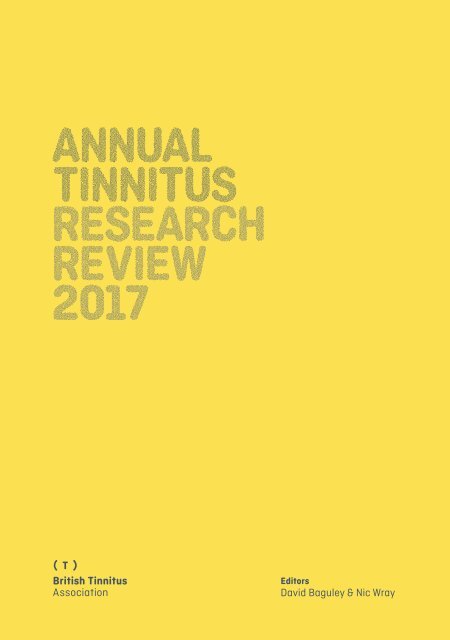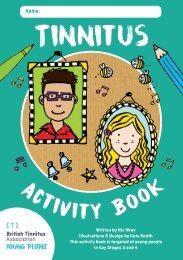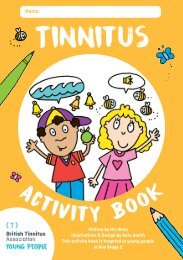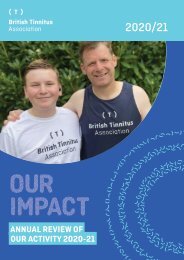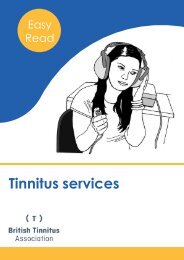The British Tinnitus Association Research Programme
You also want an ePaper? Increase the reach of your titles
YUMPU automatically turns print PDFs into web optimized ePapers that Google loves.
ANNUAL<br />
TINNITUS<br />
RESEARCH<br />
REVIEW<br />
2017<br />
Editors<br />
David Baguley & Nic Wray
Annual <strong>Tinnitus</strong> <strong>Research</strong> Review 2017.<br />
Copyright © <strong>British</strong> <strong>Tinnitus</strong> <strong>Association</strong> 2017.<br />
Editors: David Baguley & Nic Wray<br />
<strong>The</strong> editors would like to thank all the contributors for their<br />
support and enthusiasm. We would also like to thank the copyright<br />
owners of the images and figures reproduced in this publication for<br />
their permission to reproduce them either directly or via licence.<br />
We believe that all such work has been acknowledged, but please<br />
contact Nic Wray on nic@tinnitus.org.uk if any have been<br />
inadvertently omitted.<br />
<strong>British</strong> <strong>Tinnitus</strong> <strong>Association</strong><br />
Unit 5 Acorn Business Park<br />
Woodseats Close<br />
Sheffield<br />
S8 0TB<br />
www.tinnitus.org.uk<br />
info@tinnitus.org.uk<br />
0114 250 9933<br />
Registered charity no. 1011145 Company limited by guarantee no.<br />
2709302, registered in England.
T<br />
<strong>British</strong> <strong>Tinnitus</strong> <strong>Association</strong><br />
THE BRITISH TINNITUS<br />
ASSOCIATION<br />
RESEARCH PROGRAMME<br />
Dr Magdalena Sereda<br />
DR MAGDALENA SEREDA<br />
Senior <strong>Research</strong> Fellow<br />
<strong>British</strong> <strong>Tinnitus</strong> <strong>Association</strong><br />
Head of <strong>Research</strong>,<br />
National Institute for<br />
Health <strong>Research</strong> (NIHR)<br />
Nottingham Biomedical<br />
<strong>Research</strong> Centre,<br />
Nottingham, UK<br />
Magdalena is a Senior <strong>Research</strong><br />
Fellow - <strong>British</strong> <strong>Tinnitus</strong> <strong>Association</strong><br />
Head of <strong>Research</strong> at the NIHR<br />
Nottingham Biomedical <strong>Research</strong><br />
Centre. Her research focuses on<br />
assessing the effectiveness of NHS<br />
contracted sound therapy options for<br />
tinnitus including hearing aids and<br />
combination hearing aids.<br />
Magdalena graduated from Warsaw<br />
University in Biology and obtained<br />
a PhD in Neuropsychology from the<br />
Institute of Experimental Biology,<br />
Warsaw. As a Guest <strong>Research</strong>er<br />
at Humboldt University, Berlin she<br />
was researching animal models of<br />
tinnitus. In 2007 she started working<br />
as a Career Development Fellow at<br />
the MRC Institute of Hearing <strong>Research</strong><br />
in Nottingham to look at objective<br />
characterisation of tinnitus using<br />
magnetoencephalography.<br />
Over the years Magdalena's research<br />
has concentrated on several aspects<br />
of the functioning of the auditory<br />
system, including cochlear implant<br />
technology and tinnitus. She has<br />
16 years’ experience of working<br />
with people with different hearing<br />
disorders including tinnitus sufferers,<br />
cochlear implant users and deaf<br />
adolescents.<br />
<strong>The</strong> vision of the <strong>British</strong> <strong>Tinnitus</strong> <strong>Association</strong> (BTA)<br />
is “A world where no one suffers from tinnitus”<br />
[1], therefore the BTA’s research programme<br />
concentrates on the areas leading towards<br />
achieving that goal. <strong>The</strong> BTA is currently supporting<br />
14 active research projects involving 21 researchers<br />
from 9 institutes across the country, investing over<br />
half of its spending in the last year in research [2].<br />
<strong>The</strong> BTA supported research concentrates around<br />
three main areas:<br />
Understanding tinnitus – with the view to<br />
facilitate the development of a cure<br />
Management – including existing and novel<br />
practice and treatment<br />
Prevention – use of ear protection by<br />
young people<br />
Understanding tinnitus<br />
Although research is ongoing, there is currently no<br />
pharmacological treatment that has been approved<br />
specifically for tinnitus. <strong>The</strong> route to developing new<br />
treatments is complex and involves extensive preclinical<br />
work before any testing in humans can begin.<br />
That includes developing a thorough understanding<br />
of the mechanisms involved in tinnitus generation,<br />
identifying therapeutic targets, investigating what<br />
effects the drug can have on the organism, checking<br />
if the drug is safe, estimating a dose for use in people<br />
etc. Usually, both in vitro (studies with microorganisms,<br />
cells or molecules outside of the body) and in vivo<br />
(studies involving living organisms) are needed before<br />
the new treatment can be tested in a series of clinical<br />
trials.<br />
Dr Martine Hamann from the University of Leicester is<br />
currently conducting an early work that is looking at<br />
molecular mechanisms of tinnitus and aims to identify<br />
novel genetic targets that can be used in the treatment<br />
of hearing loss and tinnitus.<br />
Annual <strong>Tinnitus</strong> <strong>Research</strong> Review 2017<br />
5
<strong>The</strong> <strong>British</strong> <strong>Tinnitus</strong> <strong>Association</strong> research programme T <strong>British</strong> <strong>Tinnitus</strong> <strong>Association</strong><br />
Address those gaps by designing and conducting<br />
high quality clinical trials, including Randomised<br />
Controlled Trials;<br />
Disseminate results to inform and influence<br />
clinical practice and guidelines, and to engage<br />
the general public.<br />
Figure 1<br />
Martine Hamann<br />
Dr Hamann is investigating the role of microRNAs<br />
(recently discovered small molecules present in<br />
animal and human cells) in hearing loss and tinnitus.<br />
MicroRNAs play an important role in gene regulation.<br />
<strong>The</strong> first part of her work is concentrating on confirming<br />
the role of microRNAs in tinnitus in an animal model.<br />
If successful, the next step will be developing a<br />
pharmacological treatment that will target levels<br />
of these molecules and might lead to alleviation of<br />
tinnitus.<br />
Management<br />
Whilst researchers are looking for a cure, there are many<br />
different management options that can help reduce the<br />
impact of tinnitus on someone experiencing the condition.<br />
<strong>The</strong> BTA is funding research into improving currently<br />
available options as well as testing novel treatments<br />
and therapies. Other projects in this area are looking<br />
at the current clinical practice and potential areas for<br />
improvement as well as developing tools for assessing<br />
the efficacy of different management options in clinical<br />
trials.<br />
In July 2015, the BTA funded a four year Head of<br />
<strong>Research</strong> post for Dr Magdalena Sereda at the then NIHR<br />
Nottingham Hearing Biomedical <strong>Research</strong> Unit (BRU),<br />
now part of the NIHR Nottingham Biomedical <strong>Research</strong><br />
Centre. Dr Sereda’s research programme focuses on<br />
National Health Service (NHS) contracted sound therapy<br />
options (i.e. hearing aids and combination hearing aids) for<br />
tinnitus. <strong>The</strong> programme comprises studies to:<br />
Identify current clinical practice regarding sound<br />
therapy for tinnitus;<br />
Define the current state of knowledge and quality<br />
of the research evidence behind treatment<br />
options with the aim to identify gaps in current<br />
knowledge and topics where evidence needs to<br />
be provided (scoping and systematic reviews);<br />
<strong>The</strong> projects within the programme include designing<br />
and obtaining funding for a UK-wide clinical trial<br />
looking at the effectiveness of hearing aids for people<br />
with tinnitus and hearing loss and exploring current<br />
UK clinical practice around provision of combination<br />
hearing aids (amplification and sound generation within<br />
one device).<br />
As a member of the steering committee for the <strong>British</strong><br />
Society of Audiology (BSA) <strong>Tinnitus</strong> and Hyperacusis<br />
Special Interest Group, Dr Sereda is working towards<br />
creating professional tinnitus guidelines including<br />
guidelines around candidacy and fitting of combination<br />
hearing aids. Additional funding to support that work<br />
has been secured from the BSA and information about<br />
current UK practice is being gathered via a UK-wide<br />
survey. Eighty-nine clinicians have already responded<br />
and shared their practices and opinions. <strong>The</strong> next step<br />
will be a consensus exercise that will directly inform the<br />
guidelines.<br />
A recent collaboration between Dr Sereda and the<br />
BTA is focusing on mobile applications (apps) for the<br />
management of tinnitus. Currently available tinnitus<br />
apps postulate a range of mechanisms by which they<br />
might be effective for managing tinnitus including<br />
masking, modulation of brain activity, or relaxation.<br />
<strong>The</strong> study will generate the list of apps used by people<br />
with tinnitus, and explore and describe the options<br />
and management techniques available in each of<br />
those apps, their usability, and people’s experiences.<br />
<strong>The</strong> results will inform the choice of apps offered<br />
by clinicians to people with tinnitus for aiding the<br />
management of tinnitus as well as inform future<br />
research directions such as the need for effectiveness<br />
assessment.<br />
Psychological therapy is one of the tinnitus<br />
management options recommended by the Department<br />
of Health Good Practice Guide [3] Amongst different<br />
psychological approaches, therapist led Cognitive<br />
Behavioural <strong>The</strong>rapy (CBT) has good evidence for<br />
effectiveness in managing tinnitus distress [4].<br />
Another approach is Mindfulness Behavioural Cognitive<br />
<strong>The</strong>rapy (MBCT), which has been successfully applied<br />
to manage depression and chronic pain, but up to<br />
now there was no evidence for its effectiveness for<br />
6<br />
Annual <strong>Tinnitus</strong> <strong>Research</strong> Review 2017
<strong>The</strong> <strong>British</strong> <strong>Tinnitus</strong> <strong>Association</strong> research programme T <strong>British</strong> <strong>Tinnitus</strong> <strong>Association</strong><br />
tinnitus. MBCT involves teaching meditation techniques<br />
– usually in a group format – over a course of eight<br />
weeks, paying careful attention to one’s physical,<br />
emotional and cognitive experiences. Between 2013<br />
and 2015, Dr Laurence McKenna and Dr Liz Marks from<br />
University College London Hospitals (UCLH) conducted<br />
a study assessing effectiveness of MBCT for tinnitus<br />
and compared it to the Relaxation <strong>The</strong>rapy (current<br />
standard treatment). Seventy-five participants took<br />
part and the results have shown that both MBCT and<br />
Relaxation <strong>The</strong>rapy resulted in reductions in tinnitus<br />
severity, psychological distress, tinnitus loudness,<br />
anxiety and depression. However, for MBCT those<br />
positive effects lasted much longer (up to 6 months).<br />
<strong>The</strong> results were presented at the 10th International<br />
<strong>Tinnitus</strong> <strong>Research</strong> Initiative Conference and a research<br />
publication describing the results of the study has been<br />
submitted to the medical journal <strong>The</strong> Lancet. <strong>The</strong> long<br />
term goal is to adopt MBCT more widely as a treatment<br />
for tinnitus.<br />
Following on from that project, Dr McKenna and Dr<br />
Marks are continuing their research in this area by<br />
looking at how CBT can be used to treat tinnitus-related<br />
insomnia. About 70% of people with tinnitus complain<br />
of sleep disturbance including getting to sleep or<br />
staying asleep [5} {6] and poor sleep may contribute<br />
to tinnitus distress. Currently there has been limited<br />
research into tinnitus-related insomnia and the most<br />
effective management options for it. However, there is<br />
evidence that CBT can be effective for insomnia either<br />
on its own or co-morbid with other health problems.<br />
CBT for insomnia (CBTi) is now part of the NICE<br />
guidelines for the management of long term insomnia<br />
[7]. <strong>The</strong> study will assess the effectiveness of CBTi for<br />
tinnitus-related insomnia and compare it to the current<br />
standard approach of sleep hygiene.<br />
In a BTA-funded PhD project, Lucy Handscomb at the<br />
University of Nottingham is assessing a new cognitive<br />
model of tinnitus distress and its applications to patient<br />
management. Patient reported outcome measures<br />
(questionnaires) were used to assess such elements as<br />
tinnitus distress, anxiety, coping, insomnia, depression<br />
and general wellbeing and fit to the model will be<br />
tested. <strong>The</strong> ultimate goal of the project is to evaluate<br />
the interplay between current practice, patient priorities<br />
and components of the model to improve patient care.<br />
Several aspects of this work looking at properties of<br />
different questionnaire measures used in the study and<br />
methods of data collection have been published during<br />
the last year [8] [9] [10].<br />
Dr Sally Erskine from the Norfolk and Norwich Teaching<br />
Hospitals NHS Foundation Trust is exploring the<br />
application of Eye Movement Desensitisation and<br />
Reprocessing (EMDR) to treat tinnitus. Eye movement<br />
therapies have previously been used for treating<br />
phantom sensations, such as phantom limb pain (the<br />
sensation of pain in an amputated limb) [11] [12]. <strong>Tinnitus</strong><br />
may be considered a phantom auditory sensation so<br />
EMDR is a plausible treatment to test. <strong>The</strong> study will<br />
provide information on feasibility, acceptability and<br />
outcomes of EMDR in patients with tinnitus that will<br />
inform the development of a larger study looking at<br />
effectiveness of this approach.<br />
Dr Sam Lear from Sheffield Children’s Hospital<br />
is exploring the relationship between tinnitus,<br />
hyperacusis and anxiety in children aged 8-16 years.<br />
<strong>The</strong> outcome of this study may help clinicians seeing<br />
children with tinnitus and/or hyperacusis to decide<br />
whether additional treatment for anxiety may be<br />
needed.<br />
Figure 2<br />
James Jackson<br />
A questionnaire study by Dr James Jackson from<br />
Leeds Trinity University is investigating the association<br />
between personality and individual differences on<br />
tinnitus distress. Most people habituate to their tinnitus<br />
over time, however, many do not. Understanding the<br />
relationship between personality and tinnitus distress<br />
may contribute to understanding why some treatments<br />
and strategies work for some people, but not others.<br />
Shared Decision Making (SDM) is a process by which<br />
clinicians and patients are involved in decisions<br />
about their care and treatment. Despite SDM being<br />
a principle of healthcare provision highlighted by the<br />
NHS mandate [13], it is still not common in tinnitus<br />
services. In many cases, the treatments offered are<br />
those that the clinician prefers, without taking the<br />
patient’s preferences and desired outcomes into<br />
account. This results in high levels of dissatisfaction<br />
with the management options. Dr Helen Pryce from<br />
Aston University is currently developing an ‘Option<br />
Grid’ that will provide a tool for clinicians and patients<br />
Annual <strong>Tinnitus</strong> <strong>Research</strong> Review 2017<br />
7
<strong>The</strong> <strong>British</strong> <strong>Tinnitus</strong> <strong>Association</strong> research programme T <strong>British</strong> <strong>Tinnitus</strong> <strong>Association</strong><br />
to communicate the choices in a standardised way and<br />
facilitate the decision making process. Option Grids<br />
are one-page evidence-based summaries of available<br />
options, including trade-offs and frequently asked<br />
questions [14]. Firstly, the researchers will find out how<br />
decisions are made in the clinic. Secondly, they will ask<br />
people with tinnitus what they need to know to be able<br />
to make decisions about their care. <strong>The</strong> final step will<br />
be designing a randomised controlled trial to check<br />
whether the grids work.<br />
Appropriate outcome measures are of major<br />
importance in conducting clinical trials. However, there<br />
is a considerable variability in outcome measures<br />
(usually questionnaires) used in tinnitus research.<br />
In 2014 a European research network (TINNET) was<br />
funded by the COST programme, with a working group<br />
looking at development of standards for outcome<br />
measurements in clinical trials. Within that working<br />
group, a pan-European initiative called Core Outcome<br />
Measures in <strong>Tinnitus</strong> (COMiT) emerged with the aim to<br />
develop a core outcome set to be used in tinnitus trials<br />
worldwide. This initiative is led by NIHR Nottingham<br />
Hearing BRU. Dr Adele Horobin received funding<br />
from the BTA which will allow the incorporation of the<br />
patients’ voice in agreeing which aspects of tinnitus<br />
are important to measure. <strong>The</strong> study is using a Delphi<br />
review - an established method for gaining agreement<br />
between different people - and will result in the<br />
development of a ‘core outcome set’ (i.e. a list of things<br />
that should always be measured) for tinnitus. So far,<br />
patients have contributed to the project by creating<br />
plain English definitions and information sheets that will<br />
be used throughout the study.<br />
<strong>Tinnitus</strong>-specific questionnaires are an essential<br />
component of tinnitus assessment. <strong>The</strong>y can be used<br />
to measure a variety of tinnitus related symptoms and<br />
to estimate the effect of different treatments. More than<br />
10 clinical questionnaires exist for use with adults, but<br />
there are currently none in existence or appropriate<br />
for use with children. <strong>The</strong> aim of a three-year PhD<br />
project at NIHR Nottingham Hearing BRC supervised<br />
by Dr Derek Hoare is to create a questionnaire that<br />
will reliably measure tinnitus-related quality of life in<br />
children. <strong>Research</strong>ers will be following a careful and<br />
tested research approach to define why tinnitus is a<br />
problem to children. <strong>The</strong>y will gather perspectives<br />
from children who have tinnitus, their parents, and<br />
the clinicians who look after them. <strong>The</strong> project will<br />
bring together a multi-disciplinary team with combined<br />
expertise in tinnitus, clinical questionnaires, and child<br />
health.<br />
Dr James Jackson from Leeds Trinity University<br />
conducted a preliminary study looking at the potential<br />
of the Cortisol Awakening Response (CAR) as a<br />
biomarker of distress in tinnitus sufferers. Cortisol is<br />
a stress hormone that regulates the release of sugars<br />
into the blood stream. CAR is a well described and<br />
consistent phenomenon and any deviation from the<br />
usual profile may indicate that the body is under stress.<br />
Dr Jackson’s study investigated CAR in 30 participants<br />
with tinnitus and found that distressed tinnitus sufferers<br />
have low cortisol levels, which may be connected to<br />
the feelings of lack of control over tinnitus, an inability<br />
to relax and emotional distress caused by tinnitus.<br />
Currently tinnitus-related distress is measured using<br />
subjective measures such as questionnaires. CAR can<br />
provide a measure of stress and anxiety and offers a<br />
potential way to objectively measure tinnitus and the<br />
effectiveness of any tinnitus interventions. <strong>The</strong> results<br />
of the study were presented at the BTA Conference in<br />
September 2016. A larger-scale study is now needed to<br />
test whether effectiveness of tinnitus treatments can be<br />
measured using CAR.<br />
Prevention<br />
It has been well documented that exposure to loud<br />
noise is associated with a greater risk of tinnitus and<br />
hearing problems [15] [16]. Despite that, the majority<br />
of young people do not do anything to protect their<br />
hearing [17] [18]. <strong>The</strong> BTA’s prevention campaign<br />
“Plug’em” aims to encourage wearing earplugs at<br />
gigs, festivals, clubs and other places where one<br />
can be exposed to high levels of noise [11]. Dr Abby<br />
Hunter from the then NIHR Nottingham Hearing BRU,<br />
now the NIHR Nottingham Biomedical <strong>Research</strong><br />
Centre, conducted a series of focus groups and<br />
interviews with young adults to explore their attitudes<br />
to loud music, knowledge, perception of risk, and<br />
protective behaviours. <strong>The</strong> study found that people<br />
display different behaviours despite recognising that<br />
their hearing problems have been caused by noise<br />
exposure. Whilst some people had difficulty coping<br />
with their tinnitus and avoided loud places, others<br />
would carry on as normal and did not protect their ears.<br />
Only some made a positive change and decided to<br />
wear earplugs in noisy places. Dr Hunter postulated<br />
that the different behaviours can be linked to different<br />
personality types. <strong>The</strong> results of the study will aid and<br />
inform prevention campaigns and hearing education<br />
programmes that aim to raise awareness, but will also<br />
be used to motivate young adults to take preventive<br />
measures. Findings will help to design and tailor online/<br />
app-based material to address all the above issues and<br />
ultimately reduce the incidence of tinnitus and hearing<br />
loss in this population.<br />
8<br />
Annual <strong>Tinnitus</strong> <strong>Research</strong> Review 2017
<strong>The</strong> <strong>British</strong> <strong>Tinnitus</strong> <strong>Association</strong> research programme<br />
T<br />
<strong>British</strong> <strong>Tinnitus</strong> <strong>Association</strong><br />
References<br />
[1] <strong>British</strong> <strong>Tinnitus</strong> <strong>Association</strong>. Our Mission [Online]. Available<br />
from: www.tinnitus.org.uk/our-mission (last accessed<br />
21/05/2017)<br />
[2] <strong>British</strong> <strong>Tinnitus</strong> <strong>Association</strong>. Annual Review 2016 [Online].<br />
Available from: www.tinnitus.org.uk/blog/annual-review-2016<br />
(last accessed 21/05/2017)<br />
[3] Department of Health. Provision of Services for Adults<br />
with <strong>Tinnitus</strong>: A Good Practice Guide, 2009. [Online].<br />
Available from: http://webarchive.nationalarchives.gov.<br />
uk/20130107105354/http:/www.dh.gov.uk/prod_consum_<br />
dh/groups/dh_digitalassets/documents/digitalasset/<br />
dh_093810.pdf (last accessed 21/05/2017)<br />
[4] Martinez-Devesa P, Perera R, <strong>The</strong>odoulou M, Waddell<br />
A. Cognitive behavioural therapy for tinnitus. Cochrane<br />
Database of Systematic Reviews 2010 Sep 8, (9):CD005233.<br />
doi: 10.1002/14651858.CD005233.pub3.<br />
[5] Crönlein T, Langguth B, Pregler M, Kreuzer P, Wetter T,<br />
Schecklmann M. Insomnia in patients with chronic tinnitus:<br />
Cognitive and emotional distress and as moderator variables.<br />
Journal of Psychosomatic <strong>Research</strong>, 2016. 83: 65-68.<br />
[6] Langguth B. A review of tinnitus symptoms beyond ‘ringing<br />
in the ears’: a call to action. Current Medical <strong>Research</strong> and<br />
Opinion. 2011, 27(8), 1635-43.<br />
[7] National Institute for Health and Care Excellence. Clinical<br />
Knowledge Summaries: Insomnia. Scenario: Managing<br />
long-term insomnia (>4 weeks) [online] Available from: https://<br />
cks.nice.org.uk/insomnia#!scenariorecommendation:4 (last<br />
accessed 05/06/2017)<br />
[8] Handscomb L, Hall DA, Shorter GW, Hoare DJ. Online Data<br />
Collection to Evaluate a <strong>The</strong>oretical Cognitive Model of<br />
<strong>Tinnitus</strong>. American Journal of Audiology. 2016, 25(3S):313-<br />
317.<br />
[9] Handscomb L, Hall DA, Hoare DJ, Shorter GW. Confirmatory<br />
factor analysis of Clinical Outcomes in Routine Evaluation<br />
(CORE-OM) used as a measure of emotional distress in<br />
people with tinnitus. Health and Quality of Life Outcomes.<br />
2016, 14(1):124.<br />
[10] Handscomb LE, Hall DA, Shorter GW, Hoare DJ. Positive and<br />
Negative Thinking in <strong>Tinnitus</strong>: Factor Structure of the <strong>Tinnitus</strong><br />
Cognitions Questionnaire. Ear Hear. 2017, 38(1):126-132.<br />
[11] Schneider J, Hofmann A, Rost C, Shapiro F. EMDR in the<br />
treatment of chronic phantom limb pain. Pain Medicine,<br />
2008, 9(1): 76-82.<br />
[12] Silver S., Rogers S. Russell M. Eye movement desensitization<br />
and reprocessing (EMDR) in the treatment of war veterans.<br />
Journal of Clinical Psychology. 2008, 64(8): 947-57.<br />
[13] <strong>The</strong> Department of Health. <strong>The</strong> Government’s mandate<br />
to NHS England for 2017-2018 [online]. Available from<br />
https://www.gov.uk/government/uploads/system/uploads/<br />
attachment_data/file/601188/NHS_Mandate_2017-18_A.pdf<br />
(last accessed 05/06/2017)<br />
[14] EBSCO Health Option Grid decision aids. Available from<br />
https://health.ebsco.com/products/option-grid (last accessed<br />
05/06/2017)<br />
[15] Potier M, Hoquet C, Lloyd R, Nicolas-Puel C, Uziel A and Puel<br />
JL. <strong>The</strong> risks of amplified music for disc-jockeys working in<br />
nightclubs. Ear and hearing, 2009, 30: 291-3.<br />
[16] Serra MR, Biassoni EC, Richter U, Minoldo G, Franco<br />
G, Abraham S, Carignani JA, Joakes S and Yacci MT.<br />
Recreational noise exposure and its effects on the hearing<br />
of adolescents. Part I: An interdisciplinary long-term study.<br />
International Journal of Audiology, 2005, 44: 65-73.<br />
[17] Bogoch II, House RA and Kudla I. Perceptions about hearing<br />
protection and noise-induced hearing loss of attendees of<br />
rock concerts. Canadian Journal of Public Health, 2005, 96:<br />
69-72.<br />
[18] Crandell C, Mills TL and Gauthier R. Knowledge, behaviors,<br />
and attitudes about hearing loss and hearing protection<br />
among racial/ethnically diverse young adults. Journal of the<br />
National Medical <strong>Association</strong>, 2004, 96: 176.<br />
[19] <strong>British</strong> <strong>Tinnitus</strong> <strong>Association</strong>. Plug’em [Online]. Available from:<br />
www.plugem.co.uk (last accessed 21/05/2017)<br />
Disclaimer<br />
<strong>The</strong> views expressed in this publication are those of the author(s) and<br />
not necessarily those of the National Institutes of Health, the National<br />
Institute for Health <strong>Research</strong>, or the Department of Health.<br />
Annual <strong>Tinnitus</strong> <strong>Research</strong> Review 2017 9


